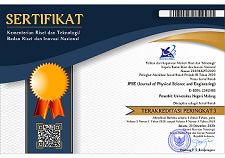Design of Flood Early Detection System using WeMos D1 Mini ESP8266 IoT Technology
Abstract
Flooding is a natural phenomenon caused by water flowing in a volume that exceeds the capacity of the media holding it. The floods affect various human activities. In addition, floods also cause material losses and other related fatalities. To overcome this problem, a flood warning system based on Arduino microcontroller technology and WeMos D1 Mini ESP8266 was designed. The data measured are water level, water velocity, and rainfall. Furthermore, the three data will be combined with Fuzzy logic to make decisions. The output of the system is in the form of a remote command signal that will activate the alarm sound and indicator lights to give a warning to the public about the potential flooding that will occur. The test results show that the measured data has become sufficient information for the microcontroller to generate the corresponding indicator lights and alarm sounds.
Keywords
Full Text:
PDFReferences
Badan Perencanaan Pembangunan Daerah, “Laporan Monitoring dan Evaluasi Kinerja Daerah Aliran Sungai Luk,” BAPPEDA: Sumbawa, Rep. TA, 2017.
Laporan Bencana Kabupaten Sumbawa, Nusa Tenggara Barat. Sumbawa: BAPPEDA, 2017.
I. Abdulrachman, B. Trianto, and D. Kurniawan, “Implementasi Internet of Things (IoT) pada Sistem Penanganan Banjir,” in Pros. Sem. Nas. Informatika Apl. (SNIA), Cimahi: Universitas Jenderal Achmad Yani, pp. C67–C70, 2017.
Y. A. Hakim, “Pengembangan Automatic Water Level Recorder (AWLR) untuk Flood Early Warning System (FEWS),” in Proc. The 5th Univ. Res. Colloq. (URECOL), Yogyakarta: Universitas Ahmad Dahlan, pp. 1602–1606, 2017.
N. A. S. Lubis, “Sistem Monitoring Level Ketinggian Air Bendungan Menggunakan Sensor Ultrasonik yang Dikontrol Melalui Android,” S.Si. Thesis, Study Program D-III of Physics, Faculty of Mathematic and Natural Sciences, Universitas Sumatra Utara, Medan, 2017.
F. N. Rachman, “Rancang Bangun Sistem Monitoring dan Pengendalian Suhu pada Inkubator Bayi Berbasis Fuzzy Logic,” S.Si. Thesis, Study Program of Technobiomedic, Faculty of Science and Technology, Universitas Airlangga, Surabaya, 2012.
A. D. Limantara, A. I. Candra, and S. W. Mudjanarko, “Manajemen Data Lalu Lintas Kendaraan Berbasis Sistem Internet Cerdas Uji Coba Implementasi di Laboratorium Universitas Kadiri,” in Pros. Sem. Nas. Sains. Tekno., Jakarta: Universitas Muhammadiyah Jakarta, pp. 1–11, 2017.
G. P. Nugroho, A. M. Shiddiqi, and H. Studiawan, “Sistem Pendeteksi Dini Banjir Menggunakan Sensor Kecepatan Air dan Sensor Ketinggian Air pada Mikrokontroler Arduino,” J. Tek. POMITS, vol. 2, no. 1, pp. 1–5, 2013.
A. Priyanto, Widyawan, and Sujoko, ”Observasi Aliran Sungai untuk Peringatan Dini Banjir Lahar Dingin Memanfaatkan Jaringan Sensor Nirkabel Platform IQRF,” TRANSMISI, vol. 16, no.1, pp. 34–37, 2014.
I. F. Putro, “Buka Tutup Tirai Garasi Otomatis dengan Sensor Hujan serta Sensor LDR (Light Dependent Resistor) Berbasis Arduino Uno,” S.T. Thesis, Study Program of Electrical Engineering, Faculty of Engineering, Universitas Muhammadiyah Surakarta, Surakarta, 2017.
R. Syam, Dasar-Dasar Teknik Sensor, Makasar: Fakultas Teknik Universitas Hasanuddin, 2013.
D. Anggraini, “Aplikasi Mikrokontroler Atmega16 sebagai Pengontrol Sistem Emergency dan Lampu Jalan yang Dilengkapi dengan Sensor Cahaya (LDR) pada Miniatur Kompleks Perumahan Modern,” S.T. Thesis, Study Program of Electrical Engineering, Faculty of Engineering, Universitas Diponegoro, Semarang, 2010.
S. Sadi and I. S. Putra, “Rancang Bangun Monitoring Ketinggian Air dan Sistem Kontrol pada Pintu Air Berbasis Arduino dan SMS Gateway,” J. Tek., vol. 7, no. 1, pp. 77–91, 2018.
M. Hidayatullah and K. Triyana, “Pengukuran Konsentrasi Larutan Sodium Hidroksida (NaOH) dengan Transduser Kapasitif,” J. Ilmu Fis. (JIF), vol. 10, no. 1, pp. 17–27, 2018.
B. Hariyanto, Esensi-Esensi Bahasa Pemrograman JAVA, Bandung: Informatika, 2015.
M. Hidayatullah, Wahyudi, and L. Mardiana, “Sistem Kendali Keran Wudhu Otomatis Menggunakan Sensor Passive Infrared (PIR) Berbasis Mikrokontroler ATMega8535l untuk Menghemat Penggunaan Air,” J. Tambora, vol. 1, no. 3, pp 30–37, 2016.
A. Kurniawan, “Rekayasa Perangkat Lunak Aplikasi Penjualan pada Toko Story Time Factory Outlet Menggunakan Pemrograman JAVA,” S.Kom. Thesis, Study Program of Computer Systems, Faculty of Information Technology, Universitas Andalas, Padang, 2013.
B. Darytamo et al., Pemrograman Berorientasi Objek dengan JAVA 2 Platform Micro Edition (J2ME), Bandung: Institut Teknologi Bandung, 2007.
M. Hidayatullah and K. Triyana, “Pengukuran Konsentrasi Larutan Gula Menggunakan Transduser Kapasitif,” J. Ilmu Fis. (JIF), vol. 9, no. 1, pp. 43–56, 2017.
A. Ristono, Manajemen Persediaan, 1st. ed., Yogyakarta: Graha Ilmu, 2009.
M. Hidayatullah, J. Fat, and T. Andriani, “Prototype Sistem Telemetri Pemantauan Kualitas Air pada Kolam Ikan Air Tawar Berbasis Mikrokontroler,” POSITRON, vol. 8, no. 2, pp. 43–52, 2018.
T. Andriani and M. Hidayatullah, “Application of I2 SHT11 Sensors on Automatic Egg Hatching Machines,” Int. J. Elect. Comm. Comp. Eng., vol. 10, no. 2, pp. 38–45, 2019.
Copyright (c) 2020 Muhammad Hidayatullah

This work is licensed under a Creative Commons Attribution-ShareAlike 4.0 International License.
This work is licensed under a Creative Commons Attribution-ShareAlike 4.0 International License



















